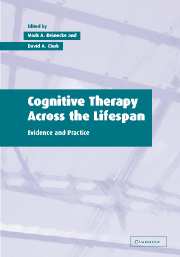Book contents
- Frontmatter
- Contents
- List of contributors
- Foreword
- 1 Cognitive therapy across the lifespan: conceptual horizons
- 2 Cognitive theory and therapy of depression
- 3 Cognitive theory and therapy of bipolar disorders
- 4 Regulation of emotion in generalized anxiety disorder
- 5 Cognitive theory and therapy of obsessions and compulsions
- 6 The cognitive model of panic
- 7 Treating obsessional problems using cognitive-behavioral therapy
- 8 Narcissistic personality disorder
- 9 Cognitive therapy and the self
- 10 Promoting cognitive change in posttraumatic stress disorder
- 11 Cognitive theory and therapy of social phobia
- 12 The cognitive model of bulimia nervosa
- 13 Cognitive therapy and schizophrenia
- 14 Cognitive-behavioral interventions for alcohol abuse and dependence
- 15 Cognitive approaches to understanding, preventing and treating child and adolescent depression
- 16 Cognitive-behavioral interventions in childhood anxiety disorders
- 17 Attention deficit/hyperactivity disorder
- 18 Cognitive-behavioral interventions for children with conduct problems
- 19 Processes of change in cognitive therapy
- 20 Cognitive therapy in the twenty-first century: current status and future directions
- Index
16 - Cognitive-behavioral interventions in childhood anxiety disorders
Published online by Cambridge University Press: 05 July 2014
- Frontmatter
- Contents
- List of contributors
- Foreword
- 1 Cognitive therapy across the lifespan: conceptual horizons
- 2 Cognitive theory and therapy of depression
- 3 Cognitive theory and therapy of bipolar disorders
- 4 Regulation of emotion in generalized anxiety disorder
- 5 Cognitive theory and therapy of obsessions and compulsions
- 6 The cognitive model of panic
- 7 Treating obsessional problems using cognitive-behavioral therapy
- 8 Narcissistic personality disorder
- 9 Cognitive therapy and the self
- 10 Promoting cognitive change in posttraumatic stress disorder
- 11 Cognitive theory and therapy of social phobia
- 12 The cognitive model of bulimia nervosa
- 13 Cognitive therapy and schizophrenia
- 14 Cognitive-behavioral interventions for alcohol abuse and dependence
- 15 Cognitive approaches to understanding, preventing and treating child and adolescent depression
- 16 Cognitive-behavioral interventions in childhood anxiety disorders
- 17 Attention deficit/hyperactivity disorder
- 18 Cognitive-behavioral interventions for children with conduct problems
- 19 Processes of change in cognitive therapy
- 20 Cognitive therapy in the twenty-first century: current status and future directions
- Index
Summary
Anxiety disorders are among the most common conditions affecting children and adolescents (Costello and Angold, 1995) with most modern epidemiological reports estimating the prevalence of significant anxiety disorders at greater than 10% worldwide (Pine, 1994) and from 12% to 20% in the USA (Kessler et al., 1994; Achenbach et al., 1995; Shaffer et al., 1996). Nevertheless, and in spite of the high prevalence, anxiety in childhood has not been as well studied as many other less common childhood disorders, possibly due to the incorrect perception that this problem is typically transient and innocuous (Benjamin et al., 1990). Over the last decade, however, our understanding of the phenomenology, prevalence, and treatment of childhood anxiety has increased dramatically. Although cognitive factors are presumed to play an important role in the expression and maintenance of childhood anxiety and most treatments contain at least some cognitive techniques specifically addressing these factors, only a handful of studies have been published investigating cognitive aspects of anxiety in children and adolescents.
In addition to the epidemiological findings, recent studies suggest that anxiety disorders in childhood are highly comorbid, relatively stable over time, and associated with significant impairment both acutely and over the long term. Clinic and community studies suggest that 50–75% of anxious children demonstrate two or more anxiety diagnoses (Costello and Angold, 1995; Last et al., 1987), and that comorbidity with both mood and externalizing disorders is also common (Bernstein and Borchardt, 1991; Ollendick and King, 1994).
- Type
- Chapter
- Information
- Cognitive Therapy across the LifespanEvidence and Practice, pp. 396 - 417Publisher: Cambridge University PressPrint publication year: 2003

